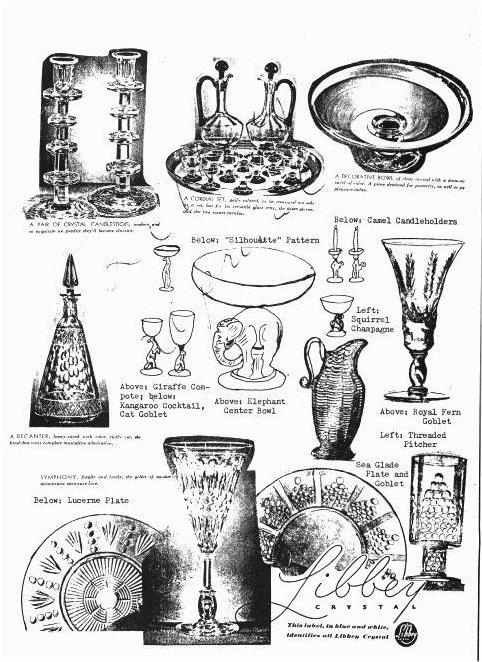National Depression Glass Association
Preserving America's Glass Manufacturing Heritage
The Libbey Glass Company
Part 3: The Libbey-Nash Series
by Virginia Scott
Glass Review - November 1978
 In 1931, The Libbey Glass Company hired A. Douglas Nash to design
what was one of the most ambitious and elaborate lines of fine glass
ever produced in modern times. Nash was the son of Arthur J. Nash, who
came from England in 1891 to be superintendent of the Tiffany Glass
Works. Nash assisted his father at Tiffany and continued with the
company until Louis Tiffany decided to discontinue the business in
1927. Tiffany allowed Nash to continue to run the furnaces but withdrew
the Tiffany name, so the A. Douglas Nash Corporation was formed. The
company did not do well and had to be liquidated in 1931. About the
same time, Libbey decided to reenter the field of fine glassware from
which it had been absent since cut glass lost its popularity after
World War I and hired Nash.
In 1931, The Libbey Glass Company hired A. Douglas Nash to design
what was one of the most ambitious and elaborate lines of fine glass
ever produced in modern times. Nash was the son of Arthur J. Nash, who
came from England in 1891 to be superintendent of the Tiffany Glass
Works. Nash assisted his father at Tiffany and continued with the
company until Louis Tiffany decided to discontinue the business in
1927. Tiffany allowed Nash to continue to run the furnaces but withdrew
the Tiffany name, so the A. Douglas Nash Corporation was formed. The
company did not do well and had to be liquidated in 1931. About the
same time, Libbey decided to reenter the field of fine glassware from
which it had been absent since cut glass lost its popularity after
World War I and hired Nash.
Douglas Nash moved to Toledo and designed the series of fine quality art glassware. An imposing catalog titled "Libbey Crystal: The New Era In Glass" introduced the series in 1933. Over 75 different patterns of formal stemware were offered, many in various color combinations. Matched centerpiece bowls, candleholders and vases were also made. The new glassware was noted for its beauty of form and was intricately decorated with cutting, engraving and such surface effects as overlay, threading and colored accents.
"Libbey Crystal is hand-blown, hand-cut," one 1933 ad declared. "No machine in the world can produce the same graceful lines, the same flashing brilliance, that identify the handiwork of the master glass craftsman." The ad went on to explain "Prices for the individual pieces begin at $2.50; stemware prices range from $10 to $2500 a dozen." The most famous piece made was a fabulous cameo-cut goblet in the Victoria pattern. This goblet required 80 hours of hand work to cut. Only one dozen were made and only two are known to exist today.
At the bottom of the page are shown illustrations of some of the glassware which was produced during the Nash era. In the center of the page are sketches of the "Silhouette" line. This pattern, handcrafted of fine lead crystal, had blown thin bowls of clear glass and stems which featured profiles of ten different animals. "Silhouette" was available with opalescent "moonstone" or black glass stems. Each item featured a different animal as follows: goblet, a cat; claret, a bear; cocktail, a kangaroo; sherry, a monkey; cordial, a greyhound: compote, a giraffe; sherbet, a rabbit; champagne, a squirrel; candlestick, a camel; center bowl, an elephant. "Silhouette" was one of the less expensive of the Nash patterns as the stems were molded and required very little hand work. The pieces, which were originally offered for $10 a dozen, are now prime collectibles and bring $100 or more apiece.
Unfortunately, the elaborate and expensive series of Nash designs was not well accepted by the buying public, which was in the midst of the depression years, so the Libbey-Nash production was doomed to failure and was discontinued in 1935.